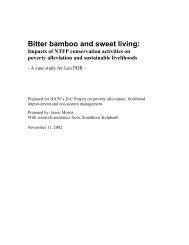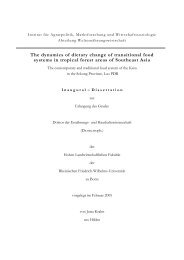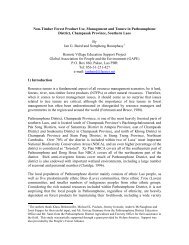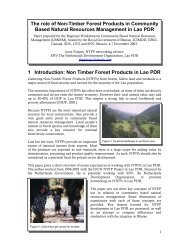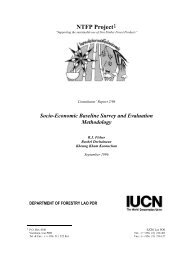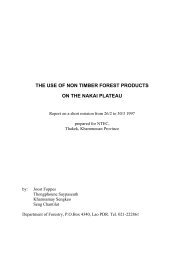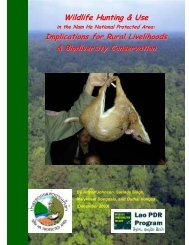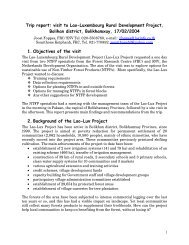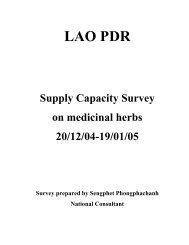3 Current trends in NTFP gathering in uplands of Lao PDR - TABI
3 Current trends in NTFP gathering in uplands of Lao PDR - TABI
3 Current trends in NTFP gathering in uplands of Lao PDR - TABI
You also want an ePaper? Increase the reach of your titles
YUMPU automatically turns print PDFs into web optimized ePapers that Google loves.
Foppes and Ketphanh, 2004. <strong>NTFP</strong>s for poverty reduction and shift<strong>in</strong>g cultivation stabilization <strong>in</strong> <strong>uplands</strong> <strong>of</strong> <strong>Lao</strong> <strong>PDR</strong>.<br />
Non-Timber Forest Products for Poverty Reduction and Shift<strong>in</strong>g<br />
Cultivation Stabilization <strong>in</strong> the Uplands <strong>of</strong> <strong>Lao</strong> <strong>PDR</strong><br />
Paper prepared for the NAFRI Workshop on Poverty Reduction and Shift<strong>in</strong>g<br />
Cultivation Stabilization <strong>in</strong> the Uplands <strong>of</strong> <strong>Lao</strong> <strong>PDR</strong>: Technologies, approaches<br />
and methods for improv<strong>in</strong>g upland livelihoods, January 27-30, 2004.<br />
Authors: Joost Foppes 1 and Sounthone Ketphanh 2<br />
Abstract:<br />
Gather<strong>in</strong>g <strong>of</strong> Non-Timber Forest Products (<strong>NTFP</strong>s) is as important for human livelihoods <strong>in</strong> the<br />
<strong>uplands</strong> <strong>of</strong> <strong>Lao</strong> <strong>PDR</strong> as agriculture and livestock. <strong>NTFP</strong>s provide food security and they are the<br />
ma<strong>in</strong> source <strong>of</strong> cash <strong>in</strong>come for people who live <strong>in</strong> the <strong>uplands</strong>. Key <strong>trends</strong> <strong>in</strong> <strong>NTFP</strong> gather<strong>in</strong>g are<br />
analyzed. <strong>NTFP</strong>s are promis<strong>in</strong>g for the development <strong>of</strong> forest-based rural micro-enterprises as a<br />
strategy for poverty alleviation. <strong>NTFP</strong>s also provide a good entry po<strong>in</strong>t to community based land<br />
use plann<strong>in</strong>g, land allocation and management. This bears consequences for the way upland<br />
development <strong>in</strong>terventions (by Government and donor-supported projects/programs) should be<br />
designed.<br />
Many <strong>NTFP</strong>s are derived from the mosaic <strong>of</strong> forests an fallows created by shift<strong>in</strong>g cultivation. A<br />
case is made for the development <strong>of</strong> long-cycle <strong>NTFP</strong> production systems that are suited to the<br />
ecology <strong>of</strong> the <strong>uplands</strong> <strong>in</strong> <strong>Lao</strong> <strong>PDR</strong>, as a strategy to stabilize shift<strong>in</strong>g cultivation, protect<br />
watersheds and conserve biodiversity <strong>of</strong> wild and cultivated species <strong>of</strong> plants and animals.<br />
1 Introduction<br />
In the <strong>uplands</strong> <strong>of</strong> <strong>Lao</strong> <strong>PDR</strong>, shift<strong>in</strong>g cultivation systems have been the<br />
predom<strong>in</strong>ant systems <strong>of</strong> land use and livelihood for centuries. Literature on<br />
shift<strong>in</strong>g cultivation tends to emphasize the agricultural component <strong>of</strong> the system.<br />
Fallow vegetation and regenerat<strong>in</strong>g forests are described ma<strong>in</strong>ly as factors<br />
contribut<strong>in</strong>g to crop production <strong>in</strong> terms <strong>of</strong> soil fertility, weed suppression and<br />
erosion prevention. Much less emphasis is given to the role <strong>of</strong> gather<strong>in</strong>g <strong>of</strong> forest<br />
products as a part <strong>of</strong> upland livelihood systems and the productivity <strong>of</strong> shift<strong>in</strong>g<br />
cultivation systems <strong>in</strong> terms <strong>of</strong> forest products.<br />
Over the last ten years, a body <strong>of</strong> evidence has emerged on the importance <strong>of</strong><br />
Non-Timber Forest Products (<strong>NTFP</strong>s) <strong>in</strong> rural livelihoods <strong>in</strong> <strong>Lao</strong> <strong>PDR</strong>. <strong>NTFP</strong>s are<br />
especially important for families <strong>in</strong> the <strong>uplands</strong>, most <strong>of</strong> whom practice shift<strong>in</strong>g<br />
cultivation. Their “pre-occupation” with gather<strong>in</strong>g and hunt<strong>in</strong>g can be observed<br />
from several angles:<br />
• The role <strong>of</strong> <strong>NTFP</strong>s <strong>in</strong> livelihoods <strong>of</strong> upland people<br />
• Time spent on gather<strong>in</strong>g <strong>NTFP</strong>s, compared to time spent on agriculture<br />
• The role <strong>of</strong> <strong>NTFP</strong>s <strong>in</strong> local knowledge and belief systems<br />
1 Mr. Foppes works for SNV, the Netherlands Development Organisation, attached as <strong>NTFP</strong><br />
adviser to the Forest Research Centre. Website: Email: jfoppes@lox<strong>in</strong>fo.com For more<br />
<strong>in</strong>formation on SNV, please consult the SNV website: www.snvworld.org<br />
2 Mr. Sounthone is the head <strong>of</strong> the <strong>NTFP</strong> section <strong>of</strong> the Forest Research Centre, National<br />
Agriculture and Forestry Research Institute, Dong Dok, Vientiane. Email:<br />
sounthone53@yahoo.com<br />
1
Foppes and Ketphanh, 2004. <strong>NTFP</strong>s for poverty reduction and shift<strong>in</strong>g cultivation stabilization <strong>in</strong> <strong>uplands</strong> <strong>of</strong> <strong>Lao</strong> <strong>PDR</strong>.<br />
• The way <strong>in</strong> which shift<strong>in</strong>g cultivators create a wide diversity <strong>of</strong> ecosystems<br />
that produce a great genetic variety <strong>of</strong> <strong>NTFP</strong>s and upland crops<br />
Each <strong>of</strong> these aspects is briefly exam<strong>in</strong>ed <strong>in</strong> chapter 2, lead<strong>in</strong>g to the conclusion<br />
that there is a need for a different view on shift<strong>in</strong>g cultivation, especially if the<br />
benefits <strong>of</strong> <strong>NTFP</strong>s gather<strong>in</strong>g are added to the equation. Shift<strong>in</strong>g cultivation is not<br />
necessarily a bad practice to be abandoned, but rather an energy-efficient system<br />
provid<strong>in</strong>g a highly diversified livelihood pattern. Chapter 3 exam<strong>in</strong>es the key<br />
<strong>trends</strong> that are caus<strong>in</strong>g changes to shift<strong>in</strong>g cultivation <strong>in</strong> the <strong>uplands</strong> <strong>of</strong> <strong>Lao</strong> <strong>PDR</strong><br />
and their impact on rural livelihoods and the environment. Left unchecked, these<br />
<strong>trends</strong> could lead to a rapid <strong>in</strong>crease <strong>in</strong> poverty and a loss <strong>of</strong> natural resources<br />
and biodiversity. Chapter 4 exam<strong>in</strong>es how <strong>NTFP</strong>s can provide a vehicle for<br />
susta<strong>in</strong>able upland development. Shift<strong>in</strong>g cultivation can be modified <strong>in</strong>to long<br />
fallow rotational upland production systems. <strong>NTFP</strong>s are also a good entry po<strong>in</strong>t<br />
for community based forest management and a good basis for <strong>in</strong>come generation,<br />
poverty alleviation and private sector development. Chapter 5 concludes how<br />
these strategies could be applied by extension agencies/projects, researchers and<br />
policy makers.<br />
2 The importance <strong>of</strong> <strong>NTFP</strong> gather<strong>in</strong>g versus agriculture<br />
<strong>in</strong> shift<strong>in</strong>g cultivation systems<br />
2.1 The role <strong>of</strong> <strong>NTFP</strong>s <strong>in</strong> the upland family economy<br />
The mosaic landscape <strong>of</strong> the <strong>uplands</strong> <strong>of</strong> <strong>Lao</strong> <strong>PDR</strong> results from a long history <strong>of</strong><br />
shift<strong>in</strong>g cultivation. It consists <strong>of</strong> a variety <strong>of</strong> forests and fallows, which produce<br />
a great amount <strong>of</strong> valuable <strong>NTFP</strong>s, provid<strong>in</strong>g a basis for export and cash <strong>in</strong>come<br />
for rural families (see box 1). Roughly 70% <strong>of</strong> <strong>Lao</strong> people live <strong>in</strong> the <strong>uplands</strong>,<br />
around half <strong>of</strong> these are practis<strong>in</strong>g shift<strong>in</strong>g cultivation <strong>in</strong> some form or another,<br />
<strong>of</strong>ten <strong>in</strong> comb<strong>in</strong>ation with other farm<strong>in</strong>g systems (UNDP 2002).<br />
Box 1: Typical <strong>NTFP</strong>s exported from <strong>Lao</strong> <strong>PDR</strong>, found <strong>in</strong> fallows derived from shift<strong>in</strong>g<br />
cultivation, with an estimate <strong>of</strong> the export volume per product per year.<br />
1 broom grass (Thysanolaema maxima), exported to Thailand to make brooms, 200 ton/year<br />
2 sweet palm fruits (Arenga westerhouttii), exported to Thailand to make sweets, 600ton/year<br />
3 paper mulberry (Broussonetia papyrifera), exported to Thailand to make paper, 500 ton/year<br />
4 benzo<strong>in</strong> (Styrax tonk<strong>in</strong>ensis), exported to France for perfume <strong>in</strong>dustry, 50 tons/year<br />
5 peuak meuak (Boehmeria malabarica), exported to Ch<strong>in</strong>a to make glue and joss-sticks, 700 ton/year<br />
6 eaglewood (Aquilaria sp.), exported to Middle East as <strong>in</strong>cense, 20 ton/year<br />
7 bitter bamboo (Indosasa ch<strong>in</strong>ensis), exported to Ch<strong>in</strong>a as fresh edible shoots, 200 ton/year<br />
8 cardamom (Amomum sp.). exported to Ch<strong>in</strong>a as medic<strong>in</strong>e, 500 ton/year<br />
(Source: Foppes & Ketphanh, 2000)<br />
Table 2 presents estimates for rural family cash <strong>in</strong>come from <strong>NTFP</strong>s from a<br />
number <strong>of</strong> recent publications. Annual family cash <strong>in</strong>come from <strong>NTFP</strong>s varies<br />
from $69-127, averag<strong>in</strong>g around 45% <strong>of</strong> family cash <strong>in</strong>come.<br />
2
Foppes and Ketphanh, 2004. <strong>NTFP</strong>s for poverty reduction and shift<strong>in</strong>g cultivation stabilization <strong>in</strong> <strong>uplands</strong> <strong>of</strong> <strong>Lao</strong> <strong>PDR</strong>.<br />
However, cash <strong>in</strong>come is only a m<strong>in</strong>or part <strong>of</strong> the total family <strong>in</strong>come. Most <strong>of</strong> the<br />
crops and products collected by <strong>Lao</strong> families from nature are directly consumed<br />
by the family, without enter<strong>in</strong>g the cash economy. Table 3 shows some estimates<br />
<strong>of</strong> this subsistence use or non-cash family <strong>in</strong>come.<br />
Table 2: Family cash <strong>in</strong>come from <strong>NTFP</strong>s per year <strong>in</strong> four prov<strong>in</strong>ce, various sources (values<br />
recalculated to US$ equivalents to compensate currency changes <strong>of</strong> <strong>Lao</strong> kip (LAK), over time).<br />
Location Khammouan Sayabouri Luang Prabang Sekong<br />
Year <strong>of</strong> data collection 1997 2001 2001 2003<br />
No <strong>of</strong> villages sampled 5 12 16 3<br />
Cash <strong>in</strong>come per family per year $ $ 170 n.a. $ 259 $ 155<br />
<strong>NTFP</strong> cash <strong>in</strong>come $ $ 69 n.a. $ 127 $ 12<br />
<strong>NTFP</strong> cash <strong>in</strong>come % 41% 44% 49% 8%<br />
livestock cash <strong>in</strong>come % 32% 8% 23% 0%<br />
other cash <strong>in</strong>come % 27% 46% 18% 92%<br />
Sources: Khammouan: (Foppes and Ketphanh 2000), Sayabouri: (Foppes, Phoutharath et al.<br />
2001) Luang Prabang: (Yokoyama 2003) Sekong: (Rosales, Kallesoe et al. 2003).<br />
Table 3: Two estimates <strong>of</strong> cash and non-cash <strong>in</strong>come per family per year <strong>of</strong> rural upland<br />
households, with special emphasis on the role <strong>of</strong> <strong>NTFP</strong> gather<strong>in</strong>g (orig<strong>in</strong>gal values were converted<br />
to US$ equivalents to compensate for currency changes <strong>of</strong> <strong>Lao</strong> kip (LAK) over time).<br />
Location Khammouan (5 villages Sekong (3 villages)<br />
Year 1997 2003<br />
Cash <strong>in</strong>come per family per year $ 170 155<br />
<strong>NTFP</strong> cash <strong>in</strong>come $ 69 12<br />
<strong>NTFP</strong> cash <strong>in</strong>come % 41% 8%<br />
livestock cash <strong>in</strong>come % 32% 0%<br />
other cash <strong>in</strong>come % 27% 92%<br />
Non-cash <strong>in</strong>come/family/year $ 519 815<br />
<strong>NTFP</strong>s for subsistence $ 200 359<br />
<strong>NTFP</strong>s for subsistence % 39% 44%<br />
Rice production 46% 32%<br />
Firewood 8% 6%<br />
Other subsistence use 7% 18%<br />
Total cash/non-cash <strong>in</strong>come $ 689 971<br />
cash <strong>in</strong>come % 25% 16%<br />
non-cash <strong>in</strong>come % 75% 84%<br />
from <strong>NTFP</strong>s $ 269 398<br />
from <strong>NTFP</strong>s % 39% 41%<br />
Expenditures for rice buy<strong>in</strong>g $ 111 87<br />
Rice buy<strong>in</strong>g as % <strong>of</strong> cash <strong>in</strong>come 65% 56%<br />
Sources: Khammouan: (Foppes and Ketphanh 2000), Sekong: (Rosales, Kallesoe et al. 2003).<br />
It is remarkable that non-cash <strong>in</strong>come contributes up to 75-84% <strong>of</strong> total family<br />
<strong>in</strong>come, cash <strong>in</strong>come only 16-25%. <strong>NTFP</strong>s provide up to half <strong>of</strong> this non-cash<br />
<strong>in</strong>come, with an equivalent value <strong>of</strong> $269-398 per family per year, even <strong>in</strong> a place<br />
3
Foppes and Ketphanh, 2004. <strong>NTFP</strong>s for poverty reduction and shift<strong>in</strong>g cultivation stabilization <strong>in</strong> <strong>uplands</strong> <strong>of</strong> <strong>Lao</strong> <strong>PDR</strong>.<br />
like Sekong, where <strong>NTFP</strong>s are not the ma<strong>in</strong> source <strong>of</strong> cash <strong>in</strong>come, but c<strong>of</strong>fee<br />
plantations.<br />
<strong>NTFP</strong>s contribute 39-44% <strong>of</strong> non-cash <strong>in</strong>come, equivalent to about $200-359 per<br />
family per year. The other ma<strong>in</strong> element <strong>of</strong> subsistence consumption is rice. It is<br />
<strong>in</strong>terest<strong>in</strong>g to note that more than half <strong>of</strong> all cash <strong>in</strong>come is used to buy rice, as<br />
many upland families cannot produce enough rice to feed their families.<br />
The l<strong>in</strong>k between <strong>NTFP</strong>s and food security deserves special mention (see box 2).<br />
Box 2: Forest foods and food security<br />
Food security is the overwhelm<strong>in</strong>g concern <strong>of</strong> most rural families <strong>in</strong> <strong>Lao</strong> <strong>PDR</strong>. Especially <strong>in</strong> hilly areas,<br />
where people are dependent on upland rice cultivation, most families are unable to produce enough<br />
rice to feed their family all year round. The ma<strong>in</strong> cop<strong>in</strong>g strategies <strong>of</strong> poor families are:<br />
• Complement<strong>in</strong>g the diet with forest foods<br />
• Sell<strong>in</strong>g <strong>NTFP</strong>s to buy rice<br />
• Borrow<strong>in</strong>g rice and pay<strong>in</strong>g back <strong>in</strong> labor<br />
A study on consumption <strong>of</strong> forest foods <strong>in</strong> three villages <strong>in</strong> Salavan prov<strong>in</strong>ce showed that:<br />
• Food security is an acute concern <strong>of</strong> most families <strong>in</strong> the study area<br />
• All families <strong>in</strong> the three villages collect forest foods on a daily basis<br />
• Villagers consume a great variety <strong>of</strong> forest foods, both animal and plant products<br />
• Forest foods are the most important source <strong>of</strong> food besides rice<br />
Forest foods provide unique advantages as a cop<strong>in</strong>g strategy for poor people:<br />
• Availability and dependability<br />
• Diversity (e.g. <strong>in</strong> the Nakai area, 223 <strong>of</strong> a total <strong>of</strong> 306 <strong>NTFP</strong>s were forest foods, see Foppes<br />
e.a., 1997)<br />
• Nutritional values<br />
• Economic and cultural values<br />
• Forest foods can substitute rice <strong>in</strong> times <strong>of</strong> great hunger<br />
• Forest foods can be exchanged for money to buy rice and avoid debt<br />
(Source: Clendon, 2000))<br />
From the above, it seems reasonable to conclude that:<br />
• <strong>NTFP</strong>s contribute as much if not more than agriculture and livestock to<br />
family <strong>in</strong>comes <strong>of</strong> upland families <strong>in</strong> <strong>Lao</strong> <strong>PDR</strong>, most <strong>of</strong> whom are <strong>in</strong>volved<br />
<strong>in</strong> shift<strong>in</strong>g cultivation;<br />
• The large amount <strong>of</strong> <strong>NTFP</strong>s used for subsistence <strong>in</strong>dicates a strong l<strong>in</strong>k<br />
between <strong>NTFP</strong>s and food security (see also Clendon, 2001). <strong>NTFP</strong>s are<br />
also a key cop<strong>in</strong>g mechanism for the poorest families <strong>in</strong> times <strong>of</strong> need.<br />
• Non-cash <strong>in</strong>come or subsistence use is much larger than cash <strong>in</strong>come <strong>in</strong><br />
the family economy <strong>of</strong> upland farmers.<br />
2.2 Time spent on gather<strong>in</strong>g <strong>NTFP</strong>s and on agriculture<br />
Several studies have estimated time spent on agriculture among shift<strong>in</strong>g<br />
cultivat<strong>in</strong>g families <strong>in</strong> <strong>Lao</strong> <strong>PDR</strong>. A recent study <strong>in</strong> Phongsaly cites an average<br />
<strong>in</strong>put <strong>of</strong> 210 mandays per family per year (Baudran 1999). There are not many<br />
4
Foppes and Ketphanh, 2004. <strong>NTFP</strong>s for poverty reduction and shift<strong>in</strong>g cultivation stabilization <strong>in</strong> <strong>uplands</strong> <strong>of</strong> <strong>Lao</strong> <strong>PDR</strong>.<br />
studies available on labour <strong>in</strong>puts for gather<strong>in</strong>g <strong>of</strong> <strong>NTFP</strong>s, which seems to<br />
<strong>in</strong>dicate a research gap. A recent study on harvest<strong>in</strong>g <strong>of</strong> bitter bamboo shoots <strong>in</strong><br />
Oudomxay quotes an average labour <strong>in</strong>put per family <strong>of</strong> 195 mandays (Morris<br />
and Ketphanh 2002). The harvest<strong>in</strong>g season for bitter bamboos is from<br />
December to April, only four months.<br />
The same families also harvest cardamom, tout tiang bark, red mushrooms,<br />
broom grass commercially dur<strong>in</strong>g other months <strong>of</strong> the year. For subsistence use,<br />
families need to collect palm leaves, bamboos, rattans etc for house construction<br />
and tools. Besides that every family has to collect firewood, vegetables, small<br />
water animals (fish, frogs, shells, crabs) and other food products for cook<strong>in</strong>g<br />
every day. It seems reasonable to conclude that the total amount <strong>of</strong> time spent on<br />
gather<strong>in</strong>g per family per year must be greater than the time spent on agriculture<br />
and livestock.<br />
2.3 <strong>NTFP</strong>s, local knowledge systems and genetic diversity<br />
People who practice shift<strong>in</strong>g cultivation <strong>in</strong> <strong>uplands</strong> <strong>of</strong> <strong>Lao</strong> <strong>PDR</strong> can easily<br />
enumerate hundreds <strong>of</strong> <strong>NTFP</strong>s they gather from forests, fallows, wetlands<br />
(Foppes, Phoutharath et al. 2001).<br />
These “repertoires <strong>of</strong> knowledge” are one <strong>of</strong> the more visible parts <strong>of</strong> local<br />
knowledge systems, developed and ma<strong>in</strong>ta<strong>in</strong>ed by local people over centuries.<br />
Other aspects <strong>of</strong> local knowledge systems are agricultural production and<br />
resource management systems, beliefs and rituals and modes <strong>of</strong> thought. There is<br />
a grow<strong>in</strong>g recognition among social scientists that these local knowledge systems<br />
are essential for susta<strong>in</strong>able development. They advocate that local knowledge<br />
systems are a key factor expla<strong>in</strong><strong>in</strong>g the vast genetic diversity <strong>of</strong> plants and<br />
animals found <strong>in</strong> <strong>uplands</strong> <strong>of</strong> Southeast Asia (Santasombat 2003).<br />
Shift<strong>in</strong>g cultivation systems are regarded as the most energy-efficient agricultural<br />
sytems <strong>in</strong> the world, where 5-50 units <strong>of</strong> food energy are obta<strong>in</strong>ed for each unit o<br />
<strong>of</strong> energy expended. In contrast, <strong>in</strong>dustrialised agriculture with large fossil fuel<br />
energy <strong>in</strong>puts need about 5-10 units <strong>of</strong> fuel energy to produce one energy unit pf<br />
food (Ramakrishnan 1992).<br />
A good example <strong>of</strong> genetic diversity created by local knowledge is the recent<br />
discovery that <strong>Lao</strong> <strong>PDR</strong> is the world’s lead<strong>in</strong>g gene pool for rice (see box 3). Local<br />
shift<strong>in</strong>g cultivators turn out to be the ma<strong>in</strong> producers <strong>of</strong> this genetic variety <strong>in</strong><br />
rice. Likewise, one could argue that shift<strong>in</strong>g cultivators have actively ma<strong>in</strong>ta<strong>in</strong>ed<br />
a wide variety <strong>of</strong> wild products <strong>in</strong> the landscape by the practices <strong>of</strong> shift<strong>in</strong>g<br />
cultivation and gather<strong>in</strong>g <strong>of</strong> <strong>NTFP</strong>s.<br />
Local knowledge systems and local practices such as shift<strong>in</strong>g cultivation, <strong>NTFP</strong><br />
gather<strong>in</strong>g and genetic variety <strong>of</strong> upland rice, should not be regarded negatively.<br />
Government, researchers and development agencies need to reth<strong>in</strong>k the role <strong>of</strong><br />
shift<strong>in</strong>g cultivation and local knowledge systems, as part <strong>of</strong> the solution for a<br />
susta<strong>in</strong>able use <strong>of</strong> <strong>uplands</strong>, <strong>NTFP</strong>s and the preservation <strong>of</strong> genetic resources.<br />
5
Foppes and Ketphanh, 2004. <strong>NTFP</strong>s for poverty reduction and shift<strong>in</strong>g cultivation stabilization <strong>in</strong> <strong>uplands</strong> <strong>of</strong> <strong>Lao</strong> <strong>PDR</strong>.<br />
Box 3: Shift<strong>in</strong>g cultivators as producers <strong>of</strong> genetic diversity<br />
Researchers <strong>of</strong> the International Rice Research Institute (IRRI) have recently identified<br />
over 13,000 local varieties <strong>of</strong> rice cultivated <strong>in</strong> <strong>Lao</strong> <strong>PDR</strong> (Appa Rao 2000). The only other<br />
country <strong>in</strong> the world to have a similar variety <strong>of</strong> rice is India, which covers a much larger<br />
area and many more ecosystems than <strong>Lao</strong> <strong>PDR</strong>. This makes <strong>Lao</strong> <strong>PDR</strong> the world’s most<br />
important gene pool <strong>of</strong> rice <strong>in</strong> the world.<br />
The vast majority <strong>of</strong> these local rice varieties <strong>in</strong> <strong>Lao</strong> <strong>PDR</strong> are glut<strong>in</strong>ous or “sticky” rice<br />
varieties, mostly grown as a staple food <strong>in</strong> <strong>uplands</strong> under shift<strong>in</strong>g cultivation. These<br />
varieties were not produced by sophisticated modern researchers, but by local people <strong>of</strong><br />
various ethnic groups, practis<strong>in</strong>g shift<strong>in</strong>g cultivation <strong>in</strong> the <strong>uplands</strong> <strong>of</strong> <strong>Lao</strong> <strong>PDR</strong>. Among<br />
these, women are the ma<strong>in</strong> managers and decision makers on rice breed<strong>in</strong>g.<br />
Now these varieties are regarded as a valuable genetic resource for the entire world. This<br />
raises the question, how these varieties should best be conserved. Specialists <strong>in</strong><br />
agricultural biodiversity argue that the best way to preserve local varieties is by<br />
preserv<strong>in</strong>g the agricultural systems and people that produced these varieties (Gemmil<br />
2001).<br />
For <strong>Lao</strong> <strong>PDR</strong>, this would actually mean that the Government would need to preserve and<br />
ma<strong>in</strong>ta<strong>in</strong> various ethnic groups liv<strong>in</strong>g <strong>in</strong> the <strong>uplands</strong>, practis<strong>in</strong>g shift<strong>in</strong>g cultivation, to keep<br />
this large number <strong>of</strong> rice varieties <strong>in</strong>tact over time. This poses an <strong>in</strong>terest<strong>in</strong>g new policy<br />
perspective, <strong>in</strong> relation to the exist<strong>in</strong>g policies towards shift<strong>in</strong>g cultivation.<br />
2.4 How shift<strong>in</strong>g cultivation produces a wide range <strong>of</strong> <strong>NTFP</strong>s<br />
Shift<strong>in</strong>g cultivation produces a landscape consist<strong>in</strong>g <strong>of</strong> a mosaic <strong>of</strong> vegetation<br />
types, represent<strong>in</strong>g fallows and forests <strong>in</strong> various stages <strong>of</strong> regeneration (Poll<strong>in</strong>i<br />
and Lamxay 1999). Each <strong>of</strong> these vegetation types produces its own specific set <strong>of</strong><br />
harvestable products, or <strong>NTFP</strong>s (see table 3).<br />
Table 3: Typical vegetation types <strong>of</strong> <strong>uplands</strong> <strong>of</strong> <strong>Lao</strong> <strong>PDR</strong> and the products<br />
gathered from them (Adapted from Poll<strong>in</strong>i and Lamxay, 1999).<br />
Vegetation type Age <strong>of</strong> vegetation Products collected<br />
Upland rice field 0-1 years 7,000 or so rice varieties, 40-60<br />
other crops<br />
Young herbaceous fallow 1-4 years Vegetables, grass for animal<br />
graz<strong>in</strong>g, grass for thatch<br />
Permanent grasslands 5 years and older Grass for animal rais<strong>in</strong>g<br />
Young secondary forest 5-15 years Cardamom, tout tiang bark, mak<br />
kha fruits<br />
Bamboo forests 5 years and older Edible bamboo shoots, bamboo<br />
canes<br />
Old secondary forest Over 15 years Timber, rattans.<br />
6
Foppes and Ketphanh, 2004. <strong>NTFP</strong>s for poverty reduction and shift<strong>in</strong>g cultivation stabilization <strong>in</strong> <strong>uplands</strong> <strong>of</strong> <strong>Lao</strong> <strong>PDR</strong>.<br />
Not all <strong>NTFP</strong>s are collected from mature forests, many <strong>NTFP</strong>s are collected from<br />
young fallows, from grasslands and wetlands as well. It would seem fair to<br />
assume that the variety <strong>of</strong> <strong>NTFP</strong>s is bigger <strong>in</strong> a mosaic <strong>of</strong> vegetation type, as<br />
produced by shift<strong>in</strong>g cultivation, than <strong>in</strong> a landscape covered by one type <strong>of</strong><br />
vegetation (crop fields, mature forest) only.<br />
The dynamics <strong>of</strong> fallow vegetations, how they depend on fallow length, soil type,<br />
slope aspect, previous vegetation etc, are still little documented and poorly<br />
understood. In a case study from Luang Nam Tha, three types <strong>of</strong> grass fallows<br />
can be dist<strong>in</strong>guished, only one will develop <strong>in</strong>to woody fallows, which become<br />
secondary forests over time. As cultivation <strong>in</strong>tensifies, the other two, more<br />
permanent grass fallows start to become more common (Poll<strong>in</strong>i and Lamxay<br />
1999).<br />
However <strong>in</strong> another case study <strong>in</strong> the prov<strong>in</strong>ce <strong>of</strong> Phongsaly, not far from Luang<br />
Nam Tha, local people report an <strong>in</strong>crease <strong>of</strong> forest fallows and a reduction <strong>of</strong><br />
grasslands over the past fifty years (Baudran 1999). This <strong>in</strong>crease <strong>of</strong> forest land<br />
<strong>in</strong> Phongsaly could well be a result <strong>of</strong> the settlement <strong>of</strong> Akha (also known as Ikho<br />
or Kho) people. Akha people <strong>in</strong> neighbor<strong>in</strong>g northern Thailand are reported to<br />
have a habit <strong>of</strong> regenerat<strong>in</strong>g forests for practical and religious purposes<br />
(Santasombat 2003).<br />
More research would seem urgently needed, as it would help us to understand<br />
better how to manage upland forest landscapes. E.g. collectors <strong>of</strong> edible bitter<br />
bamboo shoots would like to understand better why bitter bamboo forests<br />
suddenly spr<strong>in</strong>g up <strong>in</strong> some places after shift<strong>in</strong>g cultivation and why not <strong>in</strong><br />
others. Such knowledge might make it easier to stimulate the natural generation<br />
<strong>of</strong> these economically lucrative bamboo plots.<br />
3 <strong>Current</strong> <strong>trends</strong> <strong>in</strong> <strong>NTFP</strong> gather<strong>in</strong>g <strong>in</strong> <strong>uplands</strong> <strong>of</strong> <strong>Lao</strong><br />
<strong>PDR</strong><br />
<strong>NTFP</strong> gather<strong>in</strong>g <strong>in</strong> <strong>Lao</strong> <strong>PDR</strong> has changed more rapidly <strong>in</strong> the last ten years than<br />
<strong>in</strong> any other period <strong>of</strong> <strong>Lao</strong> history. The ma<strong>in</strong> factors caus<strong>in</strong>g these changes are<br />
evolv<strong>in</strong>g markets for <strong>NTFP</strong>s, population growth, forest conversion for<br />
commercial purposes and Government policies directed at upland use. This<br />
section reviews the ma<strong>in</strong> impacts <strong>of</strong> these key factors on <strong>NTFP</strong> gather<strong>in</strong>g.<br />
3.1 Evolv<strong>in</strong>g markets for <strong>NTFP</strong>s<br />
Various studies report an <strong>in</strong>creas<strong>in</strong>g trade <strong>in</strong> <strong>NTFP</strong>s to neighbour<strong>in</strong>g countries:<br />
Ch<strong>in</strong>a, Vietnam and Thailand (Yokoyama 2003), (Sayakhoumane and Bott<br />
2002). Exports <strong>of</strong> <strong>NTFP</strong>s from <strong>Lao</strong> <strong>PDR</strong> amount up to several million dollars per<br />
year. Typical products <strong>in</strong>clude:<br />
• medic<strong>in</strong>al for the Ch<strong>in</strong>ese medic<strong>in</strong>e market: cardamom (Amomum spp.),<br />
malva nuts, (Scaphium or Sterculia lychnophora), orchid stems<br />
(Dendrobium spp.)<br />
7
Foppes and Ketphanh, 2004. <strong>NTFP</strong>s for poverty reduction and shift<strong>in</strong>g cultivation stabilization <strong>in</strong> <strong>uplands</strong> <strong>of</strong> <strong>Lao</strong> <strong>PDR</strong>.<br />
• aromatic barks and woods for used for the production <strong>of</strong> <strong>in</strong>cense and<br />
perfumes: eaglewood (Aquilaria spp.), barks <strong>of</strong> Boehmeria malabarica,<br />
various Lauraceae species conta<strong>in</strong><strong>in</strong>g saffrol<br />
• food products: sugar palm fruits(Thailand), fresh <strong>of</strong>f-season bitter bamboo<br />
shoots (Ch<strong>in</strong>a)<br />
• fiber products: e.g. bamboo and rattan (Vietnam)<br />
Trends <strong>in</strong> the commercial use <strong>of</strong> <strong>NTFP</strong>s are:<br />
• Prices are stay<strong>in</strong>g low as markets are volatile and non-transparent<br />
• Prices are stay<strong>in</strong>g low because most products are sold raw, without any<br />
process<strong>in</strong>g or quality control<br />
• Lack <strong>of</strong> legislative framework to support susta<strong>in</strong>able trade <strong>in</strong> <strong>NTFP</strong>s. A<br />
recent report outl<strong>in</strong>es recommendations how to fill this gap (Sigaty 2003).<br />
• Increased gather<strong>in</strong>g for trade leads to a rapid exhaustion <strong>of</strong> natural stocks<br />
for some <strong>NTFP</strong>s, e.g. agarwood, Aquilaria sp. or aromatic barks <strong>of</strong><br />
Lauraceae spp. such as “bong” bark.<br />
• Increased demand for <strong>NTFP</strong>s starts to result <strong>in</strong> commercial plantation <strong>of</strong><br />
economically attractive species, e.g. cardamom (Amomum spp.) and bong<br />
bark (Persea kurzii).<br />
3.2 Population growth<br />
With an estimated population growth <strong>of</strong> 3.5 % per year, the population <strong>of</strong> <strong>Lao</strong><br />
<strong>PDR</strong> can be expected to double <strong>in</strong> twenty years (Foppes, Jenk<strong>in</strong>s et al. 1993).<br />
Without emigration or changes to more <strong>in</strong>tensive land use systems, this<br />
population pressure will lead to a shorten<strong>in</strong>g <strong>of</strong> fallow periods, to the extent that<br />
shift<strong>in</strong>g cultivation will no longer be possible and natural supplies <strong>of</strong> <strong>NTFP</strong>s will<br />
disappear. Local communities <strong>of</strong>ten report decl<strong>in</strong>es <strong>in</strong> availability <strong>of</strong> <strong>NTFP</strong>s over<br />
the past ten years or so (see box 4).<br />
Box 4: Example <strong>of</strong> decl<strong>in</strong><strong>in</strong>g <strong>NTFP</strong> resources due to <strong>in</strong>creased population pressure<br />
Forest dwell<strong>in</strong>g communities can make a good estimate <strong>of</strong> decl<strong>in</strong>es <strong>in</strong> <strong>of</strong>f-takes <strong>of</strong> <strong>NTFP</strong>s. The village <strong>of</strong> Ban<br />
Nong H<strong>in</strong>, Champasak, developed management systems that vary from rotational harvest<strong>in</strong>g rattans to<br />
prohibited fish<strong>in</strong>g seasons or total hunt<strong>in</strong>g bans for certa<strong>in</strong> species <strong>of</strong> wildlife.<br />
Changes <strong>in</strong> <strong>of</strong>f-takes per effort units for 3 key <strong>NTFP</strong>'s over the last 10 years (1989-1999), assessed by<br />
villagers <strong>of</strong> Ban Nong H<strong>in</strong>, Champasak, 17/2/99. (Source: Foppes & Ketphanh, 2000).<br />
<strong>NTFP</strong> 10 years ago Today<br />
Wildlife Plenty <strong>of</strong> wildlife: turtles, monitor lizards,<br />
deer, snakes, jungle fowl, other birds. You<br />
could easily hunt them <strong>in</strong> your backyard.<br />
There was no outside market, no sell<strong>in</strong>g.<br />
Only our village hunted (9 families only).<br />
Fish You could catch 4-5 kg with<strong>in</strong> 1 hour. There<br />
were only 9 families. No sell<strong>in</strong>g, no<br />
destructive methods used, only traps and<br />
nets.<br />
Rattan In 1 day, you could get 300 stems, or as<br />
many as a man can carry. We used to also<br />
have big diameter rattan, now only small<br />
diameter species.<br />
Many species disappeared: turtle, deer, jungle fowl,<br />
birds. You can walk for 48 hours and still not get<br />
anyth<strong>in</strong>g. Market demand is big, prices are gett<strong>in</strong>g<br />
higher (1 mouse-deer costs 12,000 kip). Many outsiders<br />
come to hunt <strong>in</strong> our forest. Village has 57 families now.<br />
You can not even get 0.5 kg <strong>in</strong> 1 hour. There is not<br />
enough to feed all our 57 families. Strong outside<br />
market (2,500 kip/kg). Destructive methods used by<br />
outsiders: explosives, guns, poison. Decl<strong>in</strong>e: 90%<br />
You can only get 20-30 stems <strong>in</strong> a day. Harvest<strong>in</strong>g has<br />
<strong>in</strong>tensified over the last 2 years. 1 stem sells for<br />
200kip. We know there is no quota but we need to sell<br />
anyhow. Decl<strong>in</strong>e: 90%.<br />
8
Foppes and Ketphanh, 2004. <strong>NTFP</strong>s for poverty reduction and shift<strong>in</strong>g cultivation stabilization <strong>in</strong> <strong>uplands</strong> <strong>of</strong> <strong>Lao</strong> <strong>PDR</strong>.<br />
It is difficult to obta<strong>in</strong> a clear picture <strong>of</strong> the population dynamics <strong>in</strong> the <strong>uplands</strong>.<br />
The challenge rema<strong>in</strong>s to f<strong>in</strong>d out how conservation <strong>of</strong> upland resources can be<br />
comb<strong>in</strong>ed with such a rapid population <strong>in</strong>crease.<br />
In chapter 2, we made a case for susta<strong>in</strong>able management <strong>of</strong> <strong>NTFP</strong>s <strong>in</strong> the wild.<br />
This is an essential strategy, aimed at preserv<strong>in</strong>g the nation’s biological and<br />
genetic resources. Yet it is also obvious that <strong>Lao</strong> <strong>PDR</strong>’s natural resources alone<br />
will not be able to provide enough <strong>NTFP</strong>s for the needs <strong>of</strong> tomorrow’s population.<br />
Additional production <strong>of</strong> <strong>NTFP</strong>s will have to be provided from <strong>NTFP</strong> gardens and<br />
plantations. More research is needed to develop these plantations, build<strong>in</strong>g on<br />
exist<strong>in</strong>g local knowledge.<br />
3.3 Deforestation and <strong>NTFP</strong>s<br />
Shift<strong>in</strong>g cultivation is <strong>of</strong>ten blamed for be<strong>in</strong>g the ma<strong>in</strong> cause <strong>of</strong> deforestation. Yet<br />
several studies have po<strong>in</strong>ted out that commercial logg<strong>in</strong>g and conversion <strong>of</strong><br />
forests for commercial plantations (rubber, c<strong>of</strong>fee) are the ma<strong>in</strong> causes <strong>of</strong><br />
destruction <strong>of</strong> primary forests <strong>in</strong> <strong>Lao</strong> <strong>PDR</strong> (Ducortieux 2000; Worldbank 2001).<br />
Shift<strong>in</strong>g cultivation is <strong>of</strong>ten practiced on secondary forests. Shift<strong>in</strong>g cultivators<br />
sometimes produce more forests than they destroy (Santasombat 2003). Our<br />
perspective on shift<strong>in</strong>g cultivation vis-à-vis deforestation may need to be<br />
redef<strong>in</strong>ed. As one author states: “The <strong>in</strong>clusion <strong>of</strong> slash and burn agriculture <strong>in</strong><br />
the debate on deforestation m<strong>in</strong>imises the role <strong>of</strong> timber concessions and places<br />
the blame on farmers, who cannot defend themselves” (Ducortieux 2000).<br />
Deforestation for commercial use <strong>of</strong>ten destroys the <strong>NTFP</strong> resources which local<br />
communities used to rely on for food security. In view <strong>of</strong> the volatile nature <strong>of</strong> the<br />
markets for plantation crops such as rubber and c<strong>of</strong>fee, one should ask how the<br />
loss <strong>of</strong> these <strong>NTFP</strong> resources compares economically to the risks and ga<strong>in</strong>s <strong>of</strong><br />
these plantations. Studies on costs/benefits and environmental/social impacts<br />
are urgently needed, e.g. <strong>in</strong> the prov<strong>in</strong>ce <strong>of</strong> Luang Nam Tha, were thousands <strong>of</strong><br />
hectares <strong>of</strong> primary forest have been converted to rubber plantations <strong>in</strong> 2003. All<br />
stakeholders should be <strong>in</strong>formed <strong>of</strong> the outcome <strong>of</strong> such studies should be shared<br />
with all stakeholders.<br />
3.4 Impact <strong>of</strong> Government policies on upland <strong>NTFP</strong> availability<br />
Impacts <strong>of</strong> certa<strong>in</strong> Government policies on livelihoods <strong>of</strong> upland farmers have<br />
been reported elsewhere. The ma<strong>in</strong> impact on <strong>NTFP</strong> harvest<strong>in</strong>g seems to be that<br />
policies on reduction <strong>of</strong> shift<strong>in</strong>g cultivation and land allocation reduce the area <strong>of</strong><br />
fallow land produc<strong>in</strong>g <strong>NTFP</strong>s. Land allocation policies may need to revised to<br />
allow village communities to practice long fallow rotational systems that provide<br />
them with the maximum range <strong>of</strong> <strong>NTFP</strong>s <strong>in</strong> a susta<strong>in</strong>able way (NAFRI LSUAFRP<br />
2003).<br />
9
Foppes and Ketphanh, 2004. <strong>NTFP</strong>s for poverty reduction and shift<strong>in</strong>g cultivation stabilization <strong>in</strong> <strong>uplands</strong> <strong>of</strong> <strong>Lao</strong> <strong>PDR</strong>.<br />
4 <strong>NTFP</strong>-based options for susta<strong>in</strong>able upland<br />
development<br />
In the preced<strong>in</strong>g chapters we reviewed the role <strong>of</strong> <strong>NTFP</strong>s <strong>in</strong> upland development,<br />
as well as the ma<strong>in</strong> <strong>trends</strong> affect<strong>in</strong>g that role. It seems that <strong>NTFP</strong>s provide a very<br />
good start<strong>in</strong>g po<strong>in</strong>t for:<br />
• Ma<strong>in</strong>ta<strong>in</strong><strong>in</strong>g a “social safety net” system for poor upland families<br />
• Community based management <strong>of</strong> natural resources<br />
• Private Sector Development based on forest products<br />
• Plantations <strong>of</strong> commercial <strong>NTFP</strong>s for economic development<br />
Some key strategies for each <strong>of</strong> these development options are presented here.<br />
4.1 Ma<strong>in</strong>ta<strong>in</strong><strong>in</strong>g basic food security for poor families<br />
Strategies for ma<strong>in</strong>ta<strong>in</strong><strong>in</strong>g the food security and cop<strong>in</strong>g strategy role <strong>of</strong> <strong>NTFP</strong>s for<br />
poor rural families <strong>in</strong>clude:<br />
� Put <strong>NTFP</strong> activities central <strong>in</strong> livelihood based strategies<br />
� Apply rapid appraisal tools to identify role <strong>of</strong> <strong>NTFP</strong>s <strong>in</strong> livelihoods and<br />
equity<br />
� Protect access to forest resources for poor families to ensure their food<br />
security<br />
� Promote <strong>NTFP</strong> agendas as a “must-have” for every rural development<br />
program at prov<strong>in</strong>ce/ district/ community level<br />
� Include <strong>NTFP</strong> use <strong>in</strong>dicators and criteria <strong>in</strong> livelihood assessment studies<br />
� Apply economic forest valuation studies to rural development policy<br />
development<br />
4.2 Village-based management <strong>of</strong> wild <strong>NTFP</strong>s <strong>in</strong> natural forests<br />
Strategies for <strong>NTFP</strong> based community land use plann<strong>in</strong>g and biodiversity<br />
conservation <strong>in</strong>clude:<br />
� F<strong>in</strong>d what people are us<strong>in</strong>g the forest for and issues <strong>in</strong> this use, then<br />
facilitate a process for solv<strong>in</strong>g these issues by agree<strong>in</strong>g on susta<strong>in</strong>able use<br />
rules per product, rather than for the entire forest<br />
� In land allocation, not only to focus on demarcation <strong>of</strong> areas but to<br />
facilitate agreements on the use <strong>of</strong> specific products <strong>in</strong>side forest areas<br />
� Develop frameworks for deal<strong>in</strong>g with the use <strong>of</strong> one forest block by<br />
multiple villages at sub-district level<br />
� Build on local concerns about exhaustion <strong>of</strong> <strong>NTFP</strong>s for <strong>in</strong>come, to engage<br />
local communities <strong>in</strong> us<strong>in</strong>g their local knowledge to preserve biodiversity<br />
4.3 <strong>NTFP</strong>s as a basis for Private Sector Development<br />
Strategies for improv<strong>in</strong>g <strong>NTFP</strong> based private sector trade and <strong>in</strong>dustries <strong>in</strong>clude:<br />
10
Foppes and Ketphanh, 2004. <strong>NTFP</strong>s for poverty reduction and shift<strong>in</strong>g cultivation stabilization <strong>in</strong> <strong>uplands</strong> <strong>of</strong> <strong>Lao</strong> <strong>PDR</strong>.<br />
� Strengthen<strong>in</strong>g local communities to organize <strong>NTFP</strong> production and<br />
market<strong>in</strong>g groups entrepreneurs by organiz<strong>in</strong>g producer associations<br />
� Improv<strong>in</strong>g bus<strong>in</strong>ess support services for rural micro enterprises<br />
� Strengthen associations <strong>of</strong> producers and traders at prov<strong>in</strong>ce/national<br />
level<br />
� Develop<strong>in</strong>g market and price <strong>in</strong>formation systems<br />
� Improv<strong>in</strong>g market<strong>in</strong>g/quota systems and l<strong>in</strong>k them to ecological<br />
susta<strong>in</strong>ability criteria/<strong>in</strong>dicators<br />
� Add<strong>in</strong>g value by <strong>in</strong>troduc<strong>in</strong>g quality control and product process<strong>in</strong>g<br />
techniques<br />
� Study the potential <strong>of</strong> standards-based systems, e.g. product certification<br />
� L<strong>in</strong>k <strong>NTFP</strong>s to eco-tourism (tourists <strong>in</strong>terested to learn about <strong>NTFP</strong> use)<br />
4.4 Domestication <strong>of</strong> <strong>NTFP</strong>s <strong>in</strong> gardens<br />
� Set up systems to record and support the exchange <strong>of</strong> local knowledge<br />
regard<strong>in</strong>g domestication and ecology <strong>of</strong> wild plants and animals<br />
� Identify and protect genetic resources <strong>of</strong> all <strong>NTFP</strong> species<br />
� Develop nursery and multiplication systems for key species<br />
� Agr<strong>of</strong>orestry trials to identify best practices for production <strong>of</strong> key species<br />
<strong>in</strong> gardens<br />
� Farm<strong>in</strong>g systems research to <strong>in</strong>tegrate domesticated <strong>NTFP</strong>s <strong>in</strong> long<br />
rotation hill farm<strong>in</strong>g systems<br />
� Secur<strong>in</strong>g <strong>in</strong>tellectual property rights for <strong>Lao</strong> <strong>NTFP</strong>s <strong>in</strong> a context <strong>of</strong><br />
conservation <strong>of</strong> biological/genetic diversity<br />
5 Conclusion<br />
<strong>NTFP</strong>s are important for survival <strong>of</strong> upland communities, both for cash <strong>in</strong>come<br />
as well as subsistence use. Upland farmers spend more time per year on<br />
gather<strong>in</strong>g <strong>NTFP</strong>s than on agriculture. Shift<strong>in</strong>g cultivation and <strong>NTFP</strong>s are closely<br />
related, both are part <strong>of</strong> local knowledge systems that should be preserved for<br />
susta<strong>in</strong>able use and conservation <strong>of</strong> wild and agricultural genetic resources. Long<br />
fallow rotational systems creat<strong>in</strong>g a mosaic <strong>of</strong> vegetation types are essential for<br />
the ma<strong>in</strong>tenance <strong>of</strong> the genetic variety <strong>of</strong> upland rice varieties and <strong>NTFP</strong>s.<br />
Community forest management systems need more legal and tra<strong>in</strong><strong>in</strong>g support to<br />
achieve this. Yet these systems will not be able to meet all future requirements for<br />
<strong>NTFP</strong>s from the local population and export markets. Domestication <strong>of</strong> <strong>NTFP</strong>s <strong>in</strong><br />
plantations needs to be accelerated to meet tomorrow’s demands. Private sector<br />
development needs to be stepped up to add value by better quality control,<br />
process<strong>in</strong>g and more efficient market<strong>in</strong>g <strong>of</strong> <strong>NTFP</strong>s for <strong>in</strong>come generation.<br />
Market<strong>in</strong>g analysis systems need to be set up to support these private sector<br />
developments effectively.<br />
11
Foppes and Ketphanh, 2004. <strong>NTFP</strong>s for poverty reduction and shift<strong>in</strong>g cultivation stabilization <strong>in</strong> <strong>uplands</strong> <strong>of</strong> <strong>Lao</strong> <strong>PDR</strong>.<br />
6 Literature<br />
Appa Rao, S. (2000). Collection and classification <strong>of</strong> rice germ plans from the <strong>Lao</strong><br />
<strong>PDR</strong> between 1995 and 2000. Vientiane, <strong>Lao</strong>-IRRI project: 18 pp.<br />
Baudran, E. (1999). Etude du systeme agraire du nord du district de Phongsaly.<br />
Vientiane, CCL: 119 pp. plus annexes.<br />
Ducortieux, O. (2000). Agriculture & Deforestation <strong>in</strong> <strong>Lao</strong>s: the machete, an alibi<br />
for the cha<strong>in</strong>saw? Vientiane, CCL: 3.<br />
Foppes, J., A. Jenk<strong>in</strong>s, et al. (1993). Shift<strong>in</strong>g ideas about shift<strong>in</strong>g cultivation.<br />
Shift<strong>in</strong>g Cultivation <strong>in</strong> <strong>Lao</strong> <strong>PDR</strong>. Vientiane, UNDP: 6 pp.<br />
Foppes, J. and S. Ketphanh (2000). Forest Extraction or Cultivation? Local<br />
Solutions from <strong>Lao</strong> <strong>PDR</strong>. Paper presented at the workshop on the<br />
evolution and susta<strong>in</strong>ability <strong>of</strong> “<strong>in</strong>termediate systems”<strong>of</strong> forest<br />
management, FOREASIA, 28 June- 1 July 2000, L<strong>of</strong>oten Norway. L<strong>of</strong>oten,<br />
Norway, FOREASIA: 16 pp.<br />
Foppes, J., K. Phoutharath, et al. (2001). Use <strong>of</strong> Non-Timber Forest Products <strong>in</strong><br />
12 villages <strong>of</strong> the Nam Tan Watershed, Piang district, Sayabouri Prov<strong>in</strong>ce,<br />
<strong>Lao</strong> <strong>PDR</strong>. Report on an RRA tra<strong>in</strong><strong>in</strong>g workshop and RRA surveys <strong>in</strong> 12<br />
villages <strong>in</strong> the Nam Tan Watershed Management Project, 19-21 February<br />
2001. Vientiane, UNDP, Nam Tan Watershed Management Project: 33 pp.<br />
Gemmil, B. (2001). Manag<strong>in</strong>g Agricultural Resources for Biodiversity<br />
Conservation: A Guide to Best Practices. Nairobi, Biodiversity Plann<strong>in</strong>g<br />
Support Programme, GEF/UNDP/UNEP.<br />
Morris, J. and S. Ketphanh (2002). Bitter bamboo and sweet liv<strong>in</strong>g: Impacts <strong>of</strong><br />
<strong>NTFP</strong> conservation activities on poverty alleviation and susta<strong>in</strong>able<br />
livelihoods - A case study for <strong>Lao</strong> <strong>PDR</strong> – Prepared for IUCN’s 3I-C Project<br />
on poverty alleviation, livelihood improvement and eco-system<br />
management. Vientiane, IUCN: 38 pp.<br />
NAFRI LSUAFRP, L. M. R. C. (2003). Field Report on Land use Plann<strong>in</strong>g and<br />
Land Management Activities <strong>in</strong> Nam Mo District. Vientiane, NAFRI<br />
LSUAFRP: 21.<br />
Poll<strong>in</strong>i, J. and V. Lamxay (1999). Analyse d'un terroir villageois: Ban T<strong>in</strong>tok,<br />
District de Luang Nam Tha. Luang Nam Tha, Project de Developpement<br />
Rural Integre de Luang Nam Tha, Union Europeenne.<br />
Ramakrishnan, P. S. (1992). Shift<strong>in</strong>g agriculture and susta<strong>in</strong>able development, an<br />
<strong>in</strong>terdiscipl<strong>in</strong>ary study from northeastern India. Paris, UNESCO<br />
Parthenon Publish<strong>in</strong>g Group.<br />
12
Foppes and Ketphanh, 2004. <strong>NTFP</strong>s for poverty reduction and shift<strong>in</strong>g cultivation stabilization <strong>in</strong> <strong>uplands</strong> <strong>of</strong> <strong>Lao</strong> <strong>PDR</strong>.<br />
Rosales, R. M. P., M. F. Kallesoe, et al. (2003). The economic returns from<br />
conserv<strong>in</strong>g natural forests <strong>in</strong> Sekong, <strong>Lao</strong> <strong>PDR</strong>. Vientiane, IUCN Asia,<br />
Regional Environmental Economics Program (REEP): 47 pp.<br />
Santasombat, Y. (2003). Biodiversity, local knowledge and susta<strong>in</strong>able<br />
development. Chiang Mai, Regional Center for Social Science and<br />
Susta<strong>in</strong>able Development (RCSD), Chiang Mai University.<br />
Sayakhoumane, N. and T. Bott (2002). Market<strong>in</strong>g study <strong>in</strong> Bokeo Prov<strong>in</strong>ce, GTZ<br />
RDP. Vientiane, GTZ Rural Development Project Bokeo: 30+14 pp.<br />
Sigaty, T. (2003). Report on legal framework <strong>of</strong> forestry sector for the Forestry<br />
Strategy 2020, <strong>Lao</strong> <strong>PDR</strong>. Vientiane, SIDA: 130 pp.<br />
UNDP (2002). National Human Development Report <strong>Lao</strong> <strong>PDR</strong> 2001. Vientiane,<br />
UNDP: 203 pp.<br />
Worldbank (2001). <strong>Lao</strong> <strong>PDR</strong> Production Forestry, status and issues for dialogue.<br />
Vientiane, World Bank, SIDA, F<strong>in</strong>nish Government: 53 pp.<br />
Yokoyama, S. (2003). A Geographical Study on the Basis for Existence <strong>of</strong><br />
Mounta<strong>in</strong>ous Villages <strong>in</strong> Northern <strong>Lao</strong>s. Geoscience department. Tsukuba,<br />
Japan, University <strong>of</strong> Tsukuba: 161 pp.<br />
13



